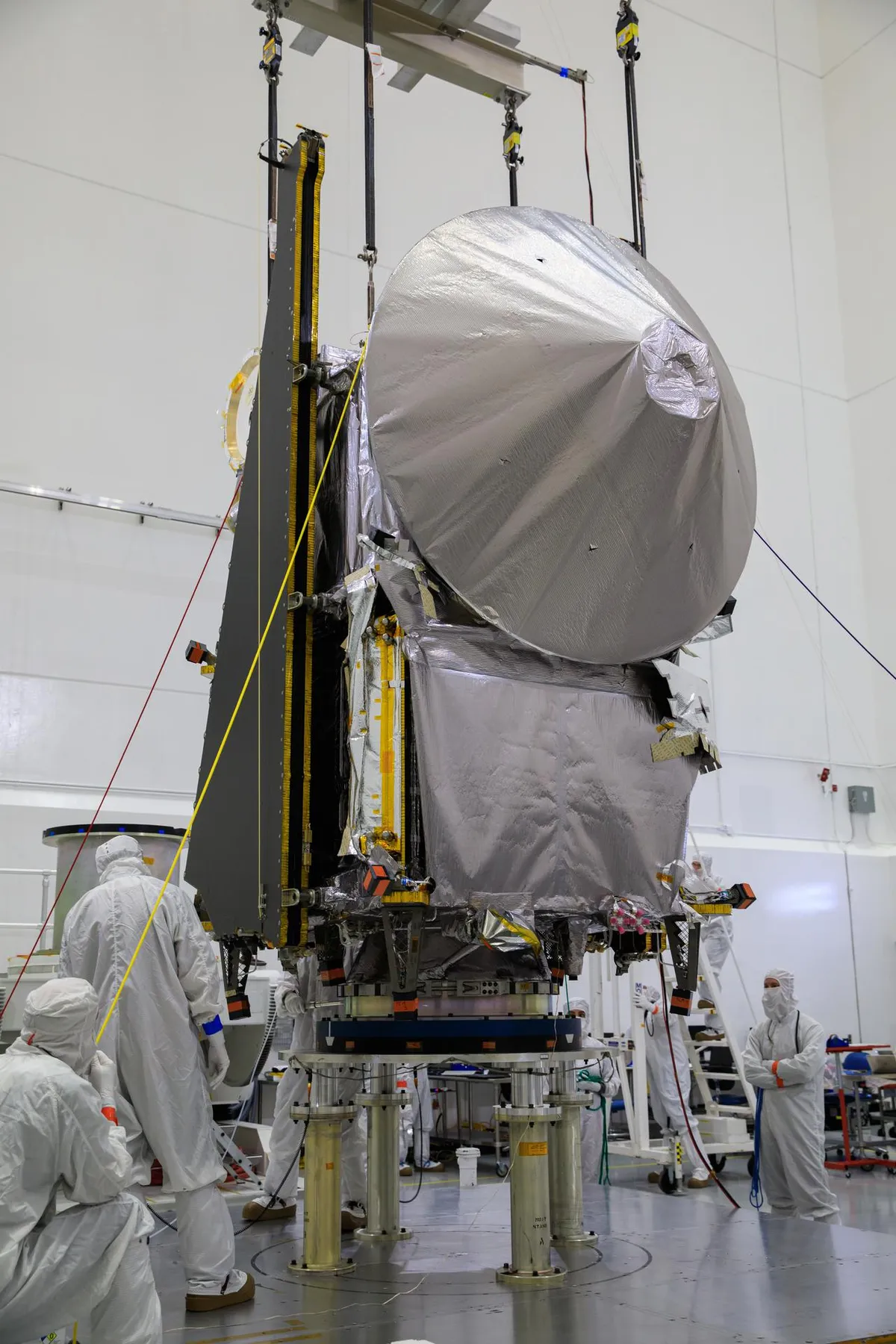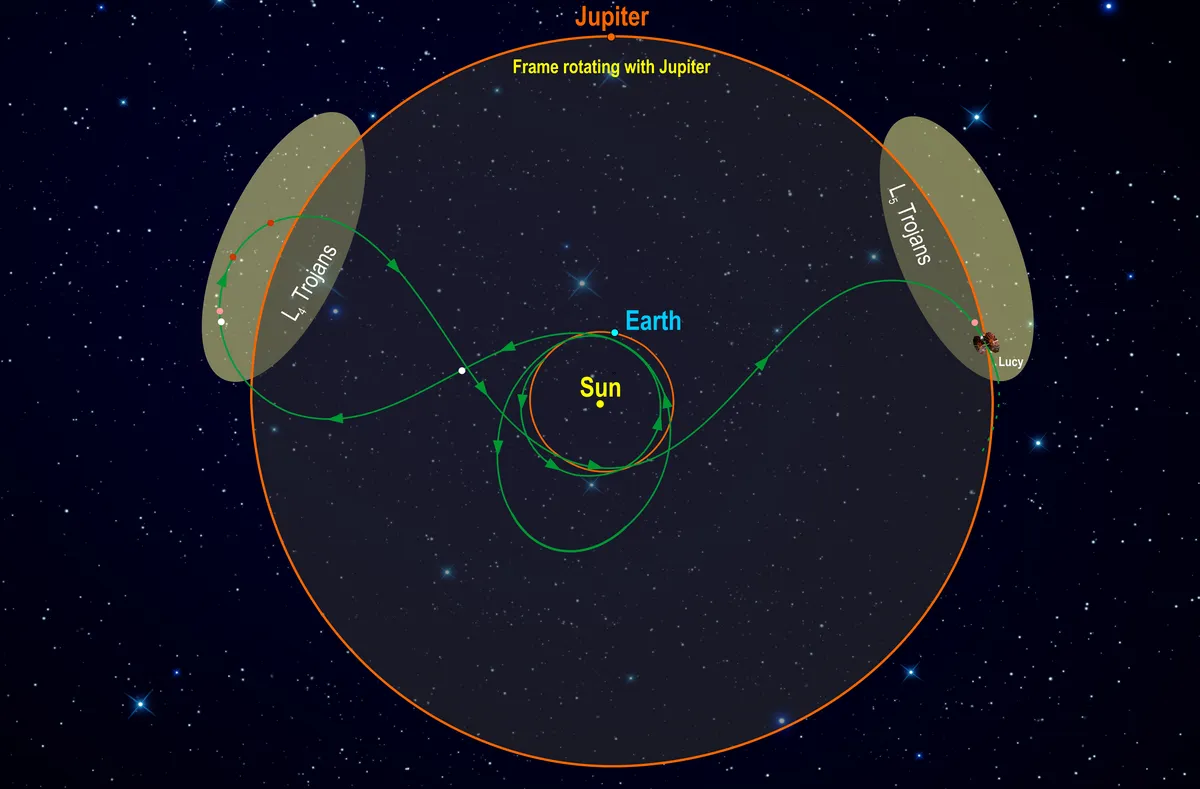NASA is set to launch the Lucy mission on Saturday 16 October. Following a six-year cruise out to the orbit of Jupiter, the mission will study a collection of ancient asteroids, known as the Trojans, for clues about the formation of the planets.
The mission is named after the famous fossilised human ancestor found in the Awash Valley, Ethiopia, in 1974 by the palaeoanthropologist Donald Johanson. Lucy – the fossil – was an example of the early hominid species, Australopithecus afarensi, who probably walked upright some 3.2 million years ago. As such, she provided unique insight into the early evolution of modern humans.
By analogy, Lucy – the spacecraft – is looking for similar insight into the early evolution of our Solar System.
The Trojan asteroids are a large collection of small celestial bodies, all trapped in the gravitational grip of Jupiter. Almost 10,000 Trojans are currently known. They are divided into two swarms, one that precedes Jupiter in its orbit and another that follows it.

What makes the Trojans so intriguing and potentially invaluable in unlocking the formation of the planets is that their compositions do not seem to be uniform.
Instead, there are three main compositional types, called P-, D-, and C-types. The first two most closely resemble the surface composition of extremely distant, icy bodies found beyond the orbit of Neptune. Meanwhile, the C-types are similar to those asteroids found in the outer parts of the main asteroid belt that lies between Mars and Jupiter.
The big question is how all these different types of asteroid came together in the same place. One man with a possible answer is Dr Hal Levison, a planetary scientist at the Southwest Research Institute, Boulder, Colorado. He is the Lucy mission’s principal investigator and thinks that it is all wrapped up in the formation of the Solar System’s outer planets Uranus and Neptune.
Known as the ice giants, the existence of Uranus and Neptune has proved difficult for astronomers to explain. Uranus orbits at 20 times further from the Sun than the Earth, whereas Neptune sits at 30, and according to computer simulations, they appear to be too large to have formed that far from the Sun.
Read more about space exploration:
- How the upcoming missions to Venus could reveal how life on Earth will end
- How humanity will return to the Moon: The future of lunar exploration
- James Webb Space Telescope: Inside the high-stakes testing of Hubble’s £7.2bn successor
In 2005, Levison and three other collaborators came together in Nice, France, to figure out a solution. The resultant ‘Nice model’ proposes that Uranus and Neptune formed much closer to the Sun, and then moved outwards through a series of gravitational interactions with the other giant planets, Jupiter and Saturn.
In their outward migration, the ice giants scattered the icy asteroids of the outer Solar System, some of which were caught by the gravity of Jupiter, resulting in the formation of the Trojans.
Other people have proposed other formation scenarios for the Trojans, hence the need for the Lucy mission to go and investigate.
“I think we've evolved to the point where we have many ideas, and don't really have enough data to distinguish one model from another. That's what led me to start thinking about putting together a Trojan asteroid mission,” says Levison.
Lucy will be launched by a United Launch Alliance Atlas V 401 rocket from Space Launch Complex 41 at Cape Canaveral, Florida. It will be folded into the nosecone of the rocket and released about an hour after launch. Once free and clear, it will deploy a pair of extraordinary solar panels.
“We are going further from the Sun on solar power than any other mission in history. We needed to push that technology. And what we came up with is truly amazing,” says Levison.
Lucy’s solar panels are circular instead of rectangular. They are made of a cloth that is twice as rigid for half the mass of a traditional solar panel. While almost seven metres in diameter when deployed, they fold into a stack just 10cm thick for launch.
The mission’s trajectory is also extraordinary. To gain enough energy to reach its targets, Lucy will return to Earth twice for a gravitational assist manoeuvre.

This will add enough energy to its orbit that it will then pass through the main asteroid belt, encountering a small asteroid in 2025 that the team have named Donaldjohanson after the Lucy fossil’s discoverer.
In August 2027, the mission arrives in the Trojan swarm that precedes Jupiter. It will spend over a year here, passing four asteroids in the process: Eurybates, Polymele, Leucus, Orus. Lucy will then fall back towards the Sun and out towards the following Trojan swarm, which it will enter in March 2033.
Here, it will fly by the binary asteroid Patroclus and Menoetius. Although that marks the end of the currently defined portion of Lucy’s mission, the spacecraft will continue to cycle between the Trojan swarms every six years, so a mission extension could take place.
And Lucy isn’t the only asteroid mission in the news. The United Arab Emirates Space Agency has announced its intention to build and fly a new mission to the main asteroid belt. The mission follows the success of the UAE’s Emirates Mars Mission. Scheduled for launch in 2028, like Lucy, this new mission will visit multiple targets.
Upon entering the main asteroid belt, it will make its first flyby in 2030 before going on to observe six more main belt asteroids over the course of the next four years. The mission will culminate in a landing on an asteroid in 2033. The timing of this mission is no accident.
In choosing the asteroid mission, UAE Space Agency was making “A calculated decision in terms of the scientific benefit down the line. So, we were looking for the sweet spot that increases the relevance of our scientific investigations,” says Sarah Al Amiri, Chair of the UAE Space Agency.
Read more about space:
- No, an asteroid probably won’t smash into the Earth the day before the US elections
- The UK missions getting us to the Moon
- What is rocket science?
That sweet spot is the comparison that they will be able to make between the main belt asteroids they study and the Lucy Trojans. The Lucy mission will be in full swing when the UAE mission starts encountering targets, and both missions will come to an end at a similar time.
In November, NASA plans to launch the DART mission. This kamikaze spacecraft is designed to hit an asteroid to fractionally change the rock's orbit. This is a test for when we spot an object heading for Earth that we will need to deflect for real.
So, it is clear that the world’s attention is turning to the asteroids, and for good reason.
“The asteroid belt is intriguing both for the historical understanding of the Solar System and of the formation of planets, but also for its forward-looking role in the future of human exploration of outer space,” says Al Amiri.